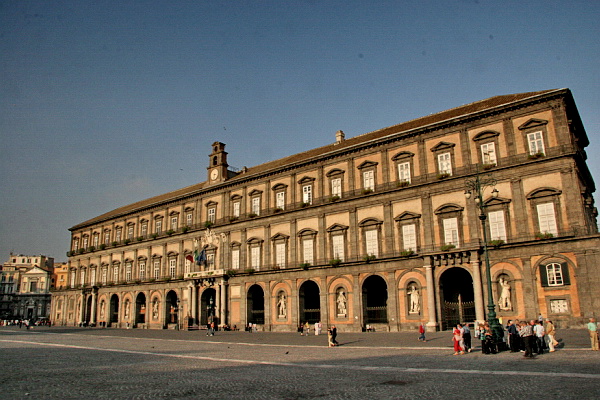Napoli - Piazza Plebiscito

Piazza Plebiscito has become the symbol of the recent renovation of Naples in the 1994, when it recovered its representative function on the occasion of G7 (actually G8, the recurrent summit of the most industrialized nations in the world). Since then, the piazza is a pedestrian area designed for the enjoyment of tourists and dwellers; every now and then here are played concerts and happenings or shown large installations of contemporary art.
Piazza Plebiscito was given its present name on the occasion of plebiscite held here on October 1860, by which Naples and the whole Southern Italy ratified their annexation to Piedmont Kingdom by Savoy. Before the piazza was called "Largo di Palazzo" (wide space in front of the Palace) because it faced main facade of the Royal Palace, which was built at the beginning of Seicento on project by architect Domenico Fontana, coming from Papal Court in Rome. It is noteworthy the great staircase leading to the noble floor, where it is possible to visit some halls, among which the Throne Room and the Court Theatre. The Royal Palace also houses the National Library.

In the open space of the piazza there had been some convents, at the beginning. The first was the franciscan monastery of the Holy Cross, made built by the Angevins and corresponding to the actual Palace of Salerno, which occupies the south edge of the square and contains in its interior the ancient Church of the Holy Cross, where he had been buried the young heir to the Angevin throne. The monastery had been demolished in 1775 and the new palace built on its place was initially a military headquarter and then private residence of the Prince of Salerno, by whom it took the name. Nowadays it is again a centre of military offices.
On the north edge of the piazza there was the Monastery of the Holy Spirit, on whose foot it developed a small suburb, around a square named "Largo Santo Spirito" corresponding to the actual Piazza Trieste e Trento. The monastery was pulled down at the beginning of the 17th century because of the construction of the Royal Palace, in order to enlarge the space in front of the main facade. The building that closes the piazza to the north (at symmetrical correspondence with the Salerno Palace) is the Palace of Foresteria (Guests) that was built in 1815 and today houses the Prefecture.

During the Aragonese reign, in the middle of the actual piazza, it rose the Convent of San Luigi, founded by San Francesco di Paola (Saint Francis from Paola) who settled in Naples when he returned from his legendary pilgrimage to the King of France. An anecdote tells that the Saint, answering to the objections raised by King Ferrante who suggested him to choose another place, predicted that it will have become "the most magnificent place in the city". The monastery was definitively destroyed during the early years of 19th century, in order to make space for the forum ordered by the Napoleonic government, during the French Decade (1805-15), with the semielliptical colonnade in neoclassic style projected by Leopoldo Laperuta.
After the Bourbon's return, Ferdinand IV King of Naples (I as King of Two Sicilies) decided to keep those works, but turning their celebrative significance to advantage of the restoration of monarchy. So he made built in the middle of the colonnade (in front of the Royal Palace) the Basilica dedicated to San Francesco di Paola, not only because he was traditionally loved and venerated by the Neapolitans, but also for the reason that he was the founder of the convent destroyed in order to make place for the Napoleonic forum.
The church, built between 1816 and 1836 following the project by Pietro Bianchi, is an imitation of the Pantheon in Rome. It has a circular plan and is covered by an hemispherical dome with a lacunar made of stone. The most valuable element in the church is certainly the main altar, richly decorated with precious marbles, designed by Ferdinando Fuga in 1751. It had been originally placed into the church of Saints Apostles, in the old center. Before the entrance there is a neoclassical porch, covered by a gable on whose vertices there are the statues of the Religion, of San Francesco di Paola and of San Ferdinando.
In the focuses of the ellipse that defines the line of colonnade, they were placed two equestrian statues made of bronze. The one on north is by Antonio Canova, who received by Joseph Bonaparte the order for a statue of his brother Napoleon riding. The order was confirmed by Ferdinand of Bourbon, but changing the figure into his father Charles. Then Ferdinand asked Canova for another statue of himself, but the artist made only the horse, while the figure was completed by his Neapolitan disciple Cali.